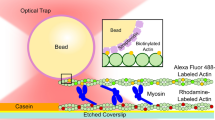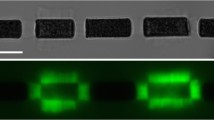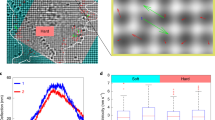Summary
We have succeeded in controlling the sliding movement of myosin-coated magnetizable beads on actin cables in Nitellopsis cells by the inhomogeneous magnetic field adjacent to a small, strong permanent magnent. The relation between magnetic force acting on the bead and the bead velocity was, in many respects, similar to that obtained from the same system by the use of centrifugal force (Oiwa et al., 1990). In particular, force favouring the motion (negative load) had little effect on the velocity until it was sufficient to pull the bead off the actin, whereas a relatively small positive load caused a reduction in velocity to a plateau value. Although the present method does not allow a good control of force direction, it demonstrates the promise of magnetic force in studying in vitro motility.
Similar content being viewed by others
References
Chaen, S., Oiwa, K., Shimmen, T., Iwamoto, H. & Sugi, H. (1989) Simultaneous recordings of force and sliding movement between a myosin-coated glass microneedle and actin cables in vitro. Proc. Natl. Acad. Sci. USA 86, 1510–14.
Civan, M. M. & Podolsky, R. J. (1966) Contraction kinetics of striated muscle following quick changes in load. J. Physiol. 184, 511–26.
Edman, K. A. P. (1979) Velocity of unloaded shortening in muscle. J. Physiol. 291, 143–59.
Hiramoto, Y. (1969) Mechanical properties of the protoplasm of the sea urchin egg. exp. Cell Res. 56, 201–8.
Huxley, A. F. & Simmons, R. M. (1971) Proposed mechanism of force generation in striated muscle. Nature 233, 533–8.
Jiles, D. (1992) Magnets and Magnetic Materials. London: Chapman & Hall.
Kron, S. J., Toyoshima, Y. Y., Uyeda, T. Q. P. & Spudich, J. A. (1991) Assays for actin sliding movement over myosincoated surfaces. Methods Enzymyol. 196, 399–416.
Oiwa, K., Chaen, S., Kamitsubo, E., Shimmen, T. & Sugi, H. (1990) Steady-state force velocity relation in the ATP-dependent sliding movement of myosin-coated beads on actin cables in vitro studied with a centrifuge microscope. Proc. Natl. Acad. Sci. USA 87, 7893–7.
Oiwa, K., Chaen, S. & Sugi, H. (1991) Measurement of work done by ATP-induced sliding between rabbit muscle myosin and algal cell actin cables in vitro. J. Physiol. 437, 751–63.
Perry, V. S. (1955) Myosin adenosinetriphosphatase. Methods Enzymol. 2, 582–8.
Shimmen, T. & Yano, M. (1984) Active sliding movement of latex beads coated with skeletal muscle myosin on Chara actin bundles. Protoplasma 121, 127–31.
TREGEAR, R., OIWA, K., CHAEN, S. & SUGI, H. (1992) The effect of magnetic force on the movement of myosin-coated beads along actin cables in an algal cell. J. Physiol. 452, 352P.
Author information
Authors and Affiliations
Rights and permissions
About this article
Cite this article
Tregear, R., Oiwa, K., Chaen, S. et al. Relation between magnetically-applied force and velocity in beads coated with rabbit myosin, sliding on actin cables in Nitellopsis cells. J Muscle Res Cell Motil 14, 412–415 (1993). https://doi.org/10.1007/BF00121292
Received:
Revised:
Accepted:
Issue Date:
DOI: https://doi.org/10.1007/BF00121292




